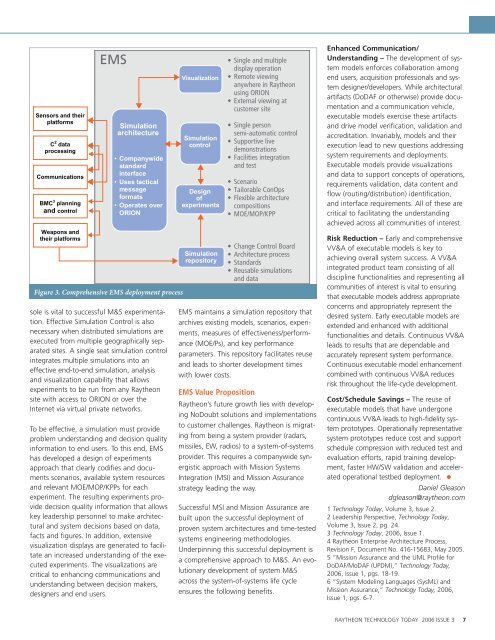Technology Today 2006 Issue 3 - Raytheon
Technology Today 2006 Issue 3 - Raytheon
Technology Today 2006 Issue 3 - Raytheon
Create successful ePaper yourself
Turn your PDF publications into a flip-book with our unique Google optimized e-Paper software.
Sensors and their<br />
platforms<br />
C 2 data<br />
processing<br />
Communications<br />
BMC 3 planning<br />
and control<br />
Weapons and<br />
their platforms<br />
EMS<br />
Simulation<br />
architecture<br />
• Companywide<br />
standard<br />
interface<br />
Uses tactical<br />
message<br />
formats<br />
Operates over<br />
ORION<br />
Figure 3. Comprehensive EMS deployment process<br />
sole is vital to successful M&S experimentation.<br />
Effective Simulation Control is also<br />
necessary when distributed simulations are<br />
executed from multiple geographically separated<br />
sites. A single seat simulation control<br />
integrates multiple simulations into an<br />
effective end-to-end simulation, analysis<br />
and visualization capability that allows<br />
experiments to be run from any <strong>Raytheon</strong><br />
site with access to ORION or over the<br />
Internet via virtual private networks.<br />
To be effective, a simulation must provide<br />
problem understanding and decision quality<br />
information to end users. To this end, EMS<br />
has developed a design of experiments<br />
approach that clearly codifies and documents<br />
scenarios, available system resources<br />
and relevant MOE/MOP/KPPs for each<br />
experiment. The resulting experiments provide<br />
decision quality information that allows<br />
key leadership personnel to make architectural<br />
and system decisions based on data,<br />
facts and figures. In addition, extensive<br />
visualization displays are generated to facilitate<br />
an increased understanding of the executed<br />
experiments. The visualizations are<br />
critical to enhancing communications and<br />
understanding between decision makers,<br />
designers and end users.<br />
Visualization<br />
Simulation<br />
control<br />
Design<br />
of<br />
experiments<br />
Simulation<br />
repository<br />
Single and multiple<br />
display operation<br />
Remote viewing<br />
anywhere in <strong>Raytheon</strong><br />
using ORION<br />
External viewing at<br />
customer site<br />
Single person<br />
semi-automatic control<br />
Supportive live<br />
demonstrations<br />
Facilities integration<br />
and test<br />
Scenario<br />
Tailorable ConOps<br />
Flexible architecture<br />
compositions<br />
MOE/MOP/KPP<br />
Change Control Board<br />
Architecture process<br />
Standards<br />
Reusable simulations<br />
and data<br />
EMS maintains a simulation repository that<br />
archives existing models, scenarios, experiments,<br />
measures of effectiveness/performance<br />
(MOE/Ps), and key performance<br />
parameters. This repository facilitates reuse<br />
and leads to shorter development times<br />
with lower costs.<br />
EMS Value Proposition<br />
<strong>Raytheon</strong>’s future growth lies with developing<br />
NoDoubt solutions and implementations<br />
to customer challenges. <strong>Raytheon</strong> is migrating<br />
from being a system provider (radars,<br />
missiles, EW, radios) to a system-of-systems<br />
provider. This requires a companywide synergistic<br />
approach with Mission Systems<br />
Integration (MSI) and Mission Assurance<br />
strategy leading the way.<br />
Successful MSI and Mission Assurance are<br />
built upon the successful deployment of<br />
proven system architectures and time-tested<br />
systems engineering methodologies.<br />
Underpinning this successful deployment is<br />
a comprehensive approach to M&S. An evolutionary<br />
development of system M&S<br />
across the system-of-systems life cycle<br />
ensures the following benefits.<br />
Enhanced Communication/<br />
Understanding – The development of system<br />
models enforces collaboration among<br />
end users, acquisition professionals and system<br />
designer/developers. While architectural<br />
artifacts (DoDAF or otherwise) provide documentation<br />
and a communication vehicle,<br />
executable models exercise these artifacts<br />
and drive model verification, validation and<br />
accreditation. Invariably, models and their<br />
execution lead to new questions addressing<br />
system requirements and deployments.<br />
Executable models provide visualizations<br />
and data to support concepts of operations,<br />
requirements validation, data content and<br />
flow (routing/distribution) identification,<br />
and interface requirements. All of these are<br />
critical to facilitating the understanding<br />
achieved across all communities of interest.<br />
Risk Reduction – Early and comprehensive<br />
VV&A of executable models is key to<br />
achieving overall system success. A VV&A<br />
integrated product team consisting of all<br />
discipline functionalities and representing all<br />
communities of interest is vital to ensuring<br />
that executable models address appropriate<br />
concerns and appropriately represent the<br />
desired system. Early executable models are<br />
extended and enhanced with additional<br />
functionalities and details. Continuous VV&A<br />
leads to results that are dependable and<br />
accurately represent system performance.<br />
Continuous executable model enhancement<br />
combined with continuous VV&A reduces<br />
risk throughout the life-cycle development.<br />
Cost/Schedule Savings – The reuse of<br />
executable models that have undergone<br />
continuous VV&A leads to high-fidelity system<br />
prototypes. Operationally representative<br />
system prototypes reduce cost and support<br />
schedule compression with reduced test and<br />
evaluation efforts, rapid training development,<br />
faster HW/SW validation and accelerated<br />
operational testbed deployment.<br />
Daniel Gleason<br />
dgleason@raytheon.com<br />
1 <strong>Technology</strong> <strong>Today</strong>, Volume 3, <strong>Issue</strong> 2.<br />
2 Leadership Perspective, <strong>Technology</strong> <strong>Today</strong>,<br />
Volume 3, <strong>Issue</strong> 2, pg. 24.<br />
3 <strong>Technology</strong> <strong>Today</strong>, <strong>2006</strong>, <strong>Issue</strong> 1.<br />
4 <strong>Raytheon</strong> Enterprise Architecture Process,<br />
Revision F, Document No. 416-15683, May 2005.<br />
5 “Mission Assurance and the UML Profile for<br />
DoDAF/MoDAF (UPDM),” <strong>Technology</strong> <strong>Today</strong>,<br />
<strong>2006</strong>, <strong>Issue</strong> 1, pgs. 18-19.<br />
6 “System Modeling Languages (SysML) and<br />
Mission Assurance,” <strong>Technology</strong> <strong>Today</strong>, <strong>2006</strong>,<br />
<strong>Issue</strong> 1, pgs. 6-7.<br />
RAYTHEON TECHNOLOGY TODAY <strong>2006</strong> ISSUE 3 7

















